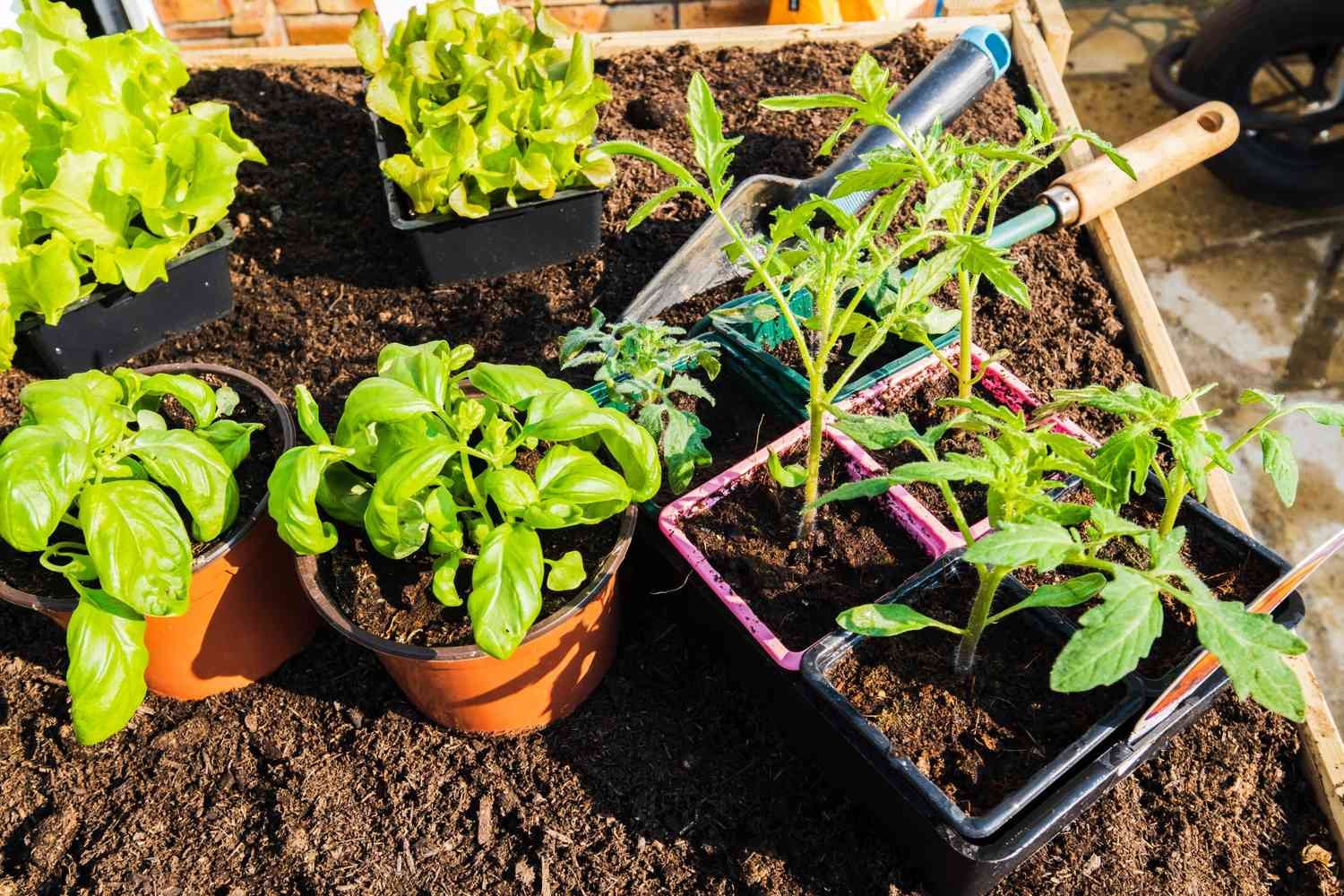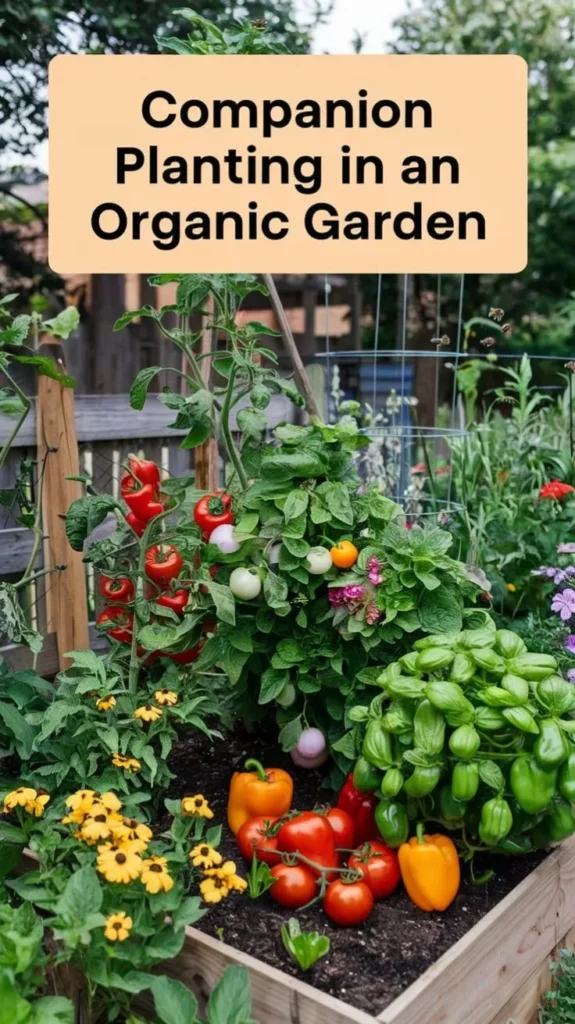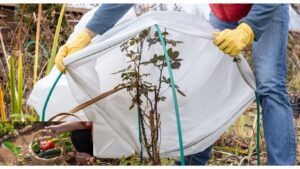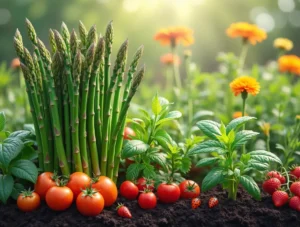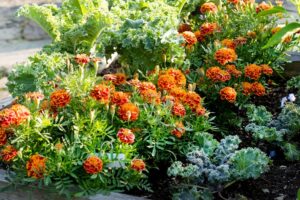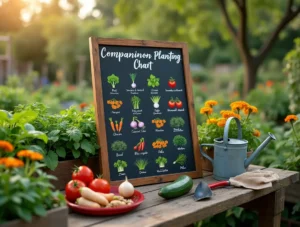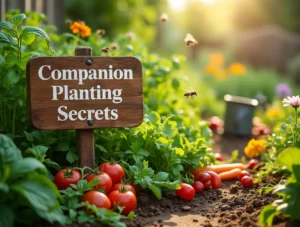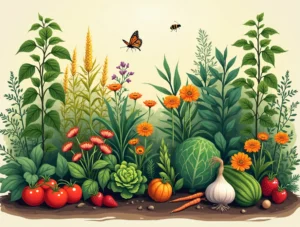Companion planting is an age-old gardening practice that involves growing different plants together to enhance growth, deter pests, and improve overall garden health. In an organic garden, where chemical interventions are avoided, companion planting becomes an essential strategy to create a balanced, resilient ecosystem. This section explores the principles of companion planting, beneficial plant pairings, and practical tips for incorporating this technique into your organic garden.
Dear Readers, If you enjoyed this article, please consider reposting the image on Pinterest to help share its value with others. Your support means a lot! Thank you!
The Principles of Companion Planting
Companion planting is based on the idea that certain plants, when grown together, can have mutually beneficial relationships. These benefits include:
- Pest Control: Some plants can repel or attract pests, protecting neighboring crops. For example, marigolds are known to deter nematodes and aphids, making them excellent companions for vegetables like tomatoes.
- Enhanced Growth: Certain plant pairings can improve growth by providing nutrients, shade, or structural support. For instance, nitrogen-fixing legumes, such as beans, can enrich the soil for heavy feeders like corn.
- Soil Improvement: Plants with deep roots, like comfrey, can bring up nutrients from deep in the soil, benefiting shallow-rooted neighbors. Additionally, cover crops like clover can fix nitrogen, improving soil fertility.
- Pollinator Attraction: Flowers like nasturtiums and calendula attract beneficial insects, such as bees and butterflies, which are essential for pollination.
- Weed Suppression: Ground-covering plants like sweet potatoes and squash can outcompete weeds by shading the soil.
Common Companion Planting Combinations
Understanding which plants work well together is key to successful companion planting. Here are some classic combinations:
- Tomatoes and Basil: Basil not only enhances the flavor of tomatoes but also repels pests like aphids, whiteflies, and mosquitoes. Planting these together can lead to healthier plants and better yields.
- Carrots and Onions: Onions release a strong odor that deters carrot flies, while carrots help to aerate the soil for onions. This pairing helps both plants thrive by reducing pest pressure.
- Beans and Corn: This combination is part of the traditional “Three Sisters” planting method, which also includes squash. Beans fix nitrogen in the soil, benefiting the heavy-feeding corn. The corn provides a natural trellis for the beans, and the squash covers the ground, suppressing weeds.
- Cucumbers and Nasturtiums: Nasturtiums act as a trap crop, attracting aphids away from cucumbers. Additionally, they repel squash bugs and beetles, which are common cucumber pests.
- Lettuce and Radishes: Lettuce provides shade for radishes, preventing them from becoming too hot and bitter. Radishes, in turn, help to break up the soil, creating a better growing environment for lettuce.
- Cabbage and Dill: Dill attracts beneficial insects like predatory wasps that feed on cabbage worms and other pests. Cabbage, in turn, provides support for the dill.
Plants to Avoid Pairing
While many plants make good companions, some combinations should be avoided as they can hinder each other’s growth or attract pests:
- Tomatoes and Corn: These two plants are both prone to similar pests, like the corn earworm and tomato hornworm, which can easily spread from one to the other.
- Onions and Beans: Onions and other alliums can stunt the growth of beans by interfering with their root systems.
- Cabbage and Strawberries: Cabbage plants can release compounds that inhibit the growth of strawberries, leading to poor fruit production.
- Carrots and Dill: Dill can stunt the growth of carrots if planted too close, especially once it begins to mature.
Planning Your Companion Planting Layout
When designing your garden layout, consider the following tips for successful companion planting:
- Start Small: If you’re new to companion planting, begin with a few simple pairings that are known to work well together. As you gain experience, you can experiment with more complex combinations.
- Consider Plant Spacing: Companion plants should be spaced properly to ensure they don’t compete for resources. For example, while basil and tomatoes are good companions, basil should be planted around the perimeter of the tomato plant rather than directly underneath it.
- Rotate Crops Annually: Rotating your crops each year helps prevent the buildup of soil-borne diseases and pests. Incorporate different companion plants into your rotation plan to maintain soil health and garden productivity.
- Use Companion Planting with Succession Planting: Combine companion planting with succession planting to maximize your garden’s yield. For example, after harvesting early crops like lettuce, plant a quick-growing companion, like radishes, in the same spot.
- Create Plant Guilds: In permaculture, a plant guild is a group of plants that work together to create a mini-ecosystem. For example, a fruit tree guild might include the tree itself, nitrogen-fixing plants like clover, and ground covers like strawberries. These plants benefit each other and create a more resilient garden system.
Companion Planting for Pest Management
One of the greatest advantages of companion planting is its role in organic pest management. By strategically placing plants that repel or trap pests, you can reduce the need for chemical interventions.
- Trap Crops: Trap crops like nasturtiums and marigolds attract pests away from your main crops. For example, planting nasturtiums near squash can attract aphids and squash bugs, sparing your vegetables.
- Repellent Plants: Certain plants emit odors that pests find unattractive. For example, garlic and chives can deter aphids and Japanese beetles, while rosemary and sage repel carrot flies and cabbage moths.
- Beneficial Insect Attraction: Flowers like calendula, alyssum, and yarrow attract beneficial insects such as ladybugs, lacewings, and parasitic wasps, which prey on garden pests. By planting these flowers throughout your garden, you create a natural defense system.
Challenges and Considerations in Companion Planting
While companion planting offers many benefits, it’s not without its challenges. Here are a few considerations to keep in mind:
- Trial and Error: Companion planting isn’t an exact science, and what works in one garden might not work in another. Be prepared for some trial and error as you figure out the best combinations for your specific garden conditions.
- Plant Growth Rates: Some plants grow faster than others, potentially overshadowing or outcompeting their companions. Monitor your garden and make adjustments as needed, such as thinning or transplanting plants to ensure everyone has enough space and resources.
- Pest Attraction: While some plants attract beneficial insects, they can also attract pests. For example, while nasturtiums are great for attracting aphids away from other plants, they can also end up hosting a large population of aphids. Regular monitoring and pest management strategies are necessary.
- Soil Nutrient Levels: Companion planting can impact soil nutrient levels, as different plants have varying nutrient needs. For example, heavy feeders like corn may deplete soil nutrients, making it necessary to replenish the soil with compost or organic fertilizers.
Case Studies: Successful Companion Planting
Case Study 1: The Three Sisters Garden The Three Sisters is a traditional Native American planting method that uses corn, beans, and squash. The corn provides a structure for the beans to climb, the beans fix nitrogen in the soil, and the squash covers the ground, suppressing weeds and retaining moisture. This symbiotic relationship results in a highly productive and sustainable garden.
Case Study 2: Marigolds and Tomatoes According to a study by the University of Florida, planting marigolds next to tomatoes significantly lowers the population of root-knot nematodes, a common pest that attacks tomato roots. The marigolds produce a chemical called alpha-terthienyl, which is toxic to nematodes, protecting the tomatoes without the need for chemical treatments.
Watering and Irrigation Techniques for an Organic Garden
Watering is one of the most critical aspects of maintaining a healthy organic garden. The right watering techniques can mean the difference between a lush, thriving garden and one that’s struggling. This section covers the essentials of watering your organic garden, from choosing the best irrigation methods to understanding the specific needs of different plants.
Understanding Plant Water Needs
Not all plants require the same amount of water, and overwatering can be just as detrimental as underwatering. Here are some general guidelines:
- Vegetables: Most vegetables need consistent moisture, especially during the growing and fruiting stages. Leafy greens like lettuce and spinach prefer consistently moist soil, while deep-rooted crops like tomatoes and squash can handle drier conditions once established.
- Herbs: Many herbs, particularly those native to the Mediterranean like rosemary, thyme, and oregano, prefer well-drained soil and don’t need as much water. However, herbs like basil and parsley require more consistent moisture.
- Flowers: The water needs of flowers vary widely. Annuals generally need more water, especially when first planted, while perennials may require less frequent watering once established.
- Fruit Trees: Young fruit trees need regular watering as they establish their root systems, but mature trees can often survive on natural rainfall alone, depending on your climate.
Understanding your garden’s soil type is also crucial. Sandy soils drain quickly and may require more frequent watering, while clay soils retain moisture longer but can become waterlogged if overwatered. Adding organic matter like compost can help improve water retention and drainage.
Best Times to Water Your Garden
Watering your garden at the right time of day is essential for minimizing water waste and reducing the risk of disease.
- Morning Watering: The best time to water your garden is in the early morning, ideally between 5 AM and 9 AM. This allows the water to soak into the soil before the heat of the day causes evaporation. Additionally, watering in the morning gives plants time to dry before nightfall, reducing the risk of fungal diseases.
- Evening Watering: If morning watering isn’t possible, evening is the next best option, but it’s important to water early enough (around 4 PM to 6 PM) to allow foliage to dry before dark. Wet leaves overnight can lead to problems like powdery mildew and other fungal issues.
- Avoid Midday Watering: Watering during the hottest part of the day should be avoided because most of the water will evaporate before it reaches the roots. Additionally, droplets of water on leaves can act like magnifying glasses, potentially scorching plants.
Efficient Irrigation Methods
Choosing the right irrigation method is key to conserving water and ensuring your plants get the moisture they need. Here are some of the most effective options for an organic garden:
- Soaker Hoses: Soaker hoses are an efficient way to water your garden because they deliver water directly to the soil, reducing evaporation and preventing foliage from getting wet. They are ideal for vegetable gardens, flower beds, and rows of shrubs.
- Drip Irrigation: Drip irrigation systems are highly efficient and customizable. They deliver water slowly and directly to the plant’s root zone, minimizing waste. Drip systems can be set up with timers to ensure consistent watering, making them a great choice for busy gardeners.
- Sprinkler Systems: While sprinkler systems can cover large areas, they are less efficient than soaker hoses or drip systems because they tend to waste water through evaporation and runoff. However, they can be useful for lawns and areas with large plantings.
- Hand Watering: For small gardens or specific plants with particular needs, hand watering with a watering can or hose allows for more control. Use a nozzle with a gentle spray to avoid displacing soil or damaging plants.
- Mulching: Mulch isn’t an irrigation method per se, but it plays a crucial role in water conservation. Applying a layer of organic mulch around your plants helps retain soil moisture, suppress weeds, and keep the soil temperature stable. Materials like straw, wood chips, and compost make excellent mulches for an organic garden.
Water Conservation Tips
In an organic garden, water conservation is important both for sustainability and plant health. Here are some tips to make the most of your water:
- Collect Rainwater: Installing rain barrels to collect water from your roof is a sustainable way to irrigate your garden. Rainwater is naturally soft and free of the chemicals found in tap water, making it ideal for plants.
- Water Deeply and Less Frequently: Instead of watering a little each day, water deeply and less frequently to encourage plants to develop deep root systems. Deep watering also reduces evaporation and runoff.
- Group Plants by Water Needs: When planning your garden, group plants with similar water needs together. This allows you to tailor your irrigation methods and avoid over- or under-watering certain plants.
- Use Gray Water: If local regulations allow, you can use gray water (recycled water from household tasks like washing dishes or laundry) for irrigation. However, be mindful to use eco-friendly, non-toxic detergents to avoid harming your plants.
- Reduce Lawn Areas: Lawns are often the biggest water users in a garden. Consider reducing lawn areas in favor of drought-tolerant plants, xeriscaping, or edible landscapes that require less water.
Troubleshooting Common Watering Problems
Even with the best intentions, watering issues can arise. Here’s how to address some common problems:
- Overwatering: Signs of overwatering include yellowing leaves, wilting despite wet soil, and root rot. To remedy this, reduce watering frequency, improve soil drainage, and ensure that your plants are not sitting in waterlogged soil.
- Underwatering: Underwatered plants may have dry, crispy leaves, stunted growth, and wilting. To fix this, water more deeply and ensure the soil is moist at least several inches below the surface.
- Water Runoff: If water is running off your garden beds rather than soaking in, it could be due to compacted soil or heavy clay. Loosen the soil, add organic matter, and use mulch to help improve water absorption.
- Uneven Watering: If some areas of your garden are thriving while others are struggling, it may be due to uneven watering. Check your irrigation system for clogs or leaks and adjust your watering schedule as needed.
Case Studies: Successful Watering Techniques
Case Study 1: Drip Irrigation in a Community Garden In a community garden in California, gardeners installed a drip irrigation system to combat the state’s frequent droughts. The system reduced water usage by 50% while improving plant health and yields. Gardeners reported fewer issues with disease and a significant reduction in water bills.
Case Study 2: Rainwater Harvesting in a Home Garden A gardener in the Pacific Northwest set up a rainwater harvesting system that collected over 1,000 gallons of water during the rainy season. This stored water was used to irrigate the garden throughout the summer, reducing dependence on municipal water and saving money. The system also prevented runoff, helping to reduce erosion and soil nutrient loss.
